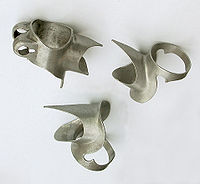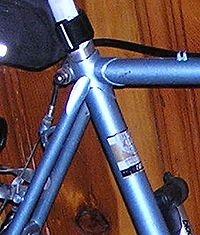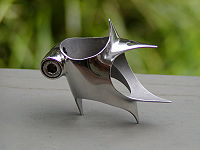
Lugged steel frame construction
Encyclopedia



Bicycle
A bicycle, also known as a bike, pushbike or cycle, is a human-powered, pedal-driven, single-track vehicle, having two wheels attached to a frame, one behind the other. A person who rides a bicycle is called a cyclist, or bicyclist....
frame
Bicycle frame
A bicycle frame is the main component of a bicycle, on to which wheels and other components are fitted. The modern and most common frame design for an upright bicycle is based on the safety bicycle, and consists of two triangles, a main triangle and a paired rear triangle...
s using steel
Steel
Steel is an alloy that consists mostly of iron and has a carbon content between 0.2% and 2.1% by weight, depending on the grade. Carbon is the most common alloying material for iron, but various other alloying elements are used, such as manganese, chromium, vanadium, and tungsten...
tubing and sockets, called lugs. For most of bicycle's history
History of the bicycle
Vehicles for human transport that have two wheels and require balancing by the rider date back to the early 19th century. The first means of transport making use of two wheels, and thus the archetype of the bicycle, was the German draisine dating back to 1817...
steel has been the primary material for bicycle frames, with lugged construction the primary assembling method. Steel continues in use by builders of high-quality steel frames, though its dominance as a frame material has waned since the mid 1990s – displaced largely by aluminum and TIG welding
Gas tungsten arc welding
Gas tungsten arc welding , also known as tungsten inert gas welding, is an arc welding process that uses a nonconsumable tungsten electrode to produce the weld...
.
Method of construction
Lugged steel construction uses standard cylindrical steel tubes which are connected with lugs, external fittings made of pieces of steel (sometimes stainless steelStainless steel
In metallurgy, stainless steel, also known as inox steel or inox from French "inoxydable", is defined as a steel alloy with a minimum of 10.5 or 11% chromium content by mass....
) which fit over the ends of the tubing. Before assembly, the builder cuts the tubes to the desired length and precisely mitres
Miter joint
A miter joint , sometimes shortened to miter, is a joint made by bevelling each of two parts to be joined, usually at a 45° angle, to form a corner, usually a 90° angle...
their ends, providing a tight fit. The end of the tubes are inserted into the lugs and subsequently brazed
Brazing
Brazing is a metal-joining process whereby a filler metal is heated above and distributed between two or more close-fitting parts by capillary action. The filler metal is brought slightly above its melting temperature while protected by a suitable atmosphere, usually a flux...
with a silver
Silver
Silver is a metallic chemical element with the chemical symbol Ag and atomic number 47. A soft, white, lustrous transition metal, it has the highest electrical conductivity of any element and the highest thermal conductivity of any metal...
or brass
Brass
Brass is an alloy of copper and zinc; the proportions of zinc and copper can be varied to create a range of brasses with varying properties.In comparison, bronze is principally an alloy of copper and tin...
filler metal. The lug greatly increases the strength of the joint by distributing the molten filler metal over a larger surface area via capillary action
Capillary action
Capillary action, or capilarity, is the ability of a liquid to flow against gravity where liquid spontanously rise in a narrow space such as between the hair of a paint-brush, in a thin tube, or in porous material such as paper or in some non-porous material such as liquified carbon fiber, or in a...
. When brazing a bicycle frame, builders may use a small scaffolding called a jig
Jig (tool)
In metalworking and woodworking, a jig is a type of tool used to control the location and/or motion of another tool. A jig's primary purpose is to provide repeatability, accuracy, and interchangeability in the manufacturing of products. A jig is often confused with a fixture; a fixture holds the...
to hold the tubes in place and maintain their precise alignment.
At least four lugs are used to construct a typical diamond frame
Bicycle frame
A bicycle frame is the main component of a bicycle, on to which wheels and other components are fitted. The modern and most common frame design for an upright bicycle is based on the safety bicycle, and consists of two triangles, a main triangle and a paired rear triangle...
:
- seat lug or seat cluster joins the top tube and seat tube; the ends of the seat stays are usually brazed directly to the sides or back of the seat lug, although some newer designs of seatlugs also have sockets for the seat stays. Also has an opening for the seatpostSeatpostA bicycle seatpost, seatpin, saddlepole, saddle pillar, or saddle pin is a tube that extends upwards from the bicycle frame to the saddle. The amount that it extends out of the frame can usually be adjusted, and there is usually a mark that indicates the minimum insertion...
- bottom bracket shell joins the chain stays, seat tube, and downtube, and includes a threaded cylindrical socket for the bottom bracketBottom bracketThe bottom bracket on a bicycle connects the crankset to the bicycle and allows the crankset to rotate freely. It contains a spindle that the crankset attaches to, and the bearings that allow the spindle and cranks to rotate. The chainrings and pedals attach to the cranks...
- upper head lug joins the head tubeHead tubeMost bicycles, tricycles and motorcycles have a tubular frame. The front fork pivots within the head tube . On a motorcycle, the "head tube" is normally called the steering head...
and top tube - lower head lug joins the head tube and down tube
The two rear dropout
Dropout (bicycle part)
A bicycle dropout is a type of fork end that allows the rear wheel to be removed without first derailing the chain. The more inclusive term fork end refers to a slot in a frame or fork where the axle of the wheel is attached....
s (which join the seat stays to the chain stays, and hold the axle
Axle
An axle is a central shaft for a rotating wheel or gear. On wheeled vehicles, the axle may be fixed to the wheels, rotating with them, or fixed to its surroundings, with the wheels rotating around the axle. In the former case, bearings or bushings are provided at the mounting points where the axle...
of the rear wheel
Bicycle wheel
A bicycle wheel is a wheel, most commonly a wire wheel, designed for bicycle. A pair is often called a wheelset, especially in the context of ready built "off the shelf" performance-oriented wheels....
) may have integral lugs in some designs. The fork
Bicycle fork
A bicycle fork is the portion of a bicycle that holds the front wheel and allows the rider to steer and balance the bicycle. A fork consists of two fork ends which hold the front wheel axle, two blades which join at a fork crown, and a steerer or steering tube to which the handlebars attach ...
dropout or ends may be joined to the fork blades using a similar method as well. The fork crown, which joins the steering tube
Bicycle fork
A bicycle fork is the portion of a bicycle that holds the front wheel and allows the rider to steer and balance the bicycle. A fork consists of two fork ends which hold the front wheel axle, two blades which join at a fork crown, and a steerer or steering tube to which the handlebars attach ...
to the fork blades, may have either an external or internal socket design.
In most lugged steel frames, the lugs have a simple pointed shape. The lug's curves maximize the strength of the joint, while minimizing the possibility of stress risers
Stress concentration
A stress concentration is a location in an object where stress is concentrated. An object is strongest when force is evenly distributed over its area, so a reduction in area, e.g. caused by a crack, results in a localized increase in stress...
, which would otherwise make the frame prone to cracking at the end of the lug.
At increased expense, frames may have lugs which are cut and filed by hand into fancy shapes, both for slight weight savings and as a display of craftsmanship. In addition many frame builders file the lugs to thin them, in order to reduce stress concentrations. These ornate or fancy lugs may be painted to accentuate their appearance.
Lugged steel frame can be repaired more easily than MIG or TIG welded steel frames; a broken tube can be removed by the application of heat to un-braze its joints, enabling tube replacement.
Steel frames generally are easier to repair than aluminium or exotic materials, and for this reason steel frames are preferred by many bicycle tourists
Bicycle touring
Bicycle touring is cycling over long distances – prioritizing pleasure and endurance over utility or speed. Touring can range from single day 'supported' rides — e.g., rides to benefit charities — where provisions are available to riders at stops along the route, to multi-day...
, who often ride long distances in remote areas. Lugs also reinforce the joints, often resulting in a stronger frame, this gives lugged frames in particular an advantage for touring cyclists.
Types of lug

Mandrel
A mandrel is one of the following:* an object used to shape machined work.* a tool component that grips or clamps materials to be machined.* a tool component that can be used to grip other moving tool components.- Variants :...
, bending them to shape, and then welding
Welding
Welding is a fabrication or sculptural process that joins materials, usually metals or thermoplastics, by causing coalescence. This is often done by melting the workpieces and adding a filler material to form a pool of molten material that cools to become a strong joint, with pressure sometimes...
the seams. These lugs are of constant thickness resulting in stress risers
Stress concentration
A stress concentration is a location in an object where stress is concentrated. An object is strongest when force is evenly distributed over its area, so a reduction in area, e.g. caused by a crack, results in a localized increase in stress...
, if large amounts of file work are not done to alter the thickness of the lug. They are easily identified by the visible seam.
Lugs used today on higher performance bicycles are investment cast
Investment casting
Investment casting is an industrial process based on and also called lost-wax casting, one of the oldest known metal-forming techniques. From 5,000 years ago, when beeswax formed the pattern, to today’s high-technology waxes, refractory materials and specialist alloys, the castings allow the...
(aka lost wax process). Copies of the lugs are made in wax, and they are attached together into a "tree". The tree is surrounded by ceramic
Ceramic
A ceramic is an inorganic, nonmetallic solid prepared by the action of heat and subsequent cooling. Ceramic materials may have a crystalline or partly crystalline structure, or may be amorphous...
and fired in a kiln, thereby melting the wax and setting the ceramic. Finally, molten steel is poured in to produce the lug. Cast lugs have many advantages over stamped lugs: they allow much finer detail, tighter tolerances (and correspondingly less manipulation and file work), and more accurate angles, and they can be made from superior materials (chromoly or stainless steel
Stainless steel
In metallurgy, stainless steel, also known as inox steel or inox from French "inoxydable", is defined as a steel alloy with a minimum of 10.5 or 11% chromium content by mass....
). The disadvantages of cast lugs are few: casting doesn't allow for long points or cutouts (done for aesthetic appeal), it is difficult to bend the lug to change the angle (requiring framebuilders to order lug sets that precisely match the desired frame geometry), and they are more expensive.
A relatively recent trend has been toward the use of stainless steel
Stainless steel
In metallurgy, stainless steel, also known as inox steel or inox from French "inoxydable", is defined as a steel alloy with a minimum of 10.5 or 11% chromium content by mass....
for investment cast lugs, as shown in the picture on the right. These lugs do not require painting, but must be brazed using silver filler rod, which necessitates much better heat control and better fit of lug to tube.
Cast lugs are found on higher quality production bikes, and virtually all custom bikes now made; stamped lugs are found on less expensive production bikes, and older custom bikes. Lugs are usually stamped with a letter or symbol code identifying the maker, and possibly the angle.
History of lugged steel construction
From the late 19th century until the 1970s, this method of frame construction was favored because the lower temperatures of brazing (silver brazing in particular) had less of a negative impact on the tubing strength than high temperature weldingWelding
Welding is a fabrication or sculptural process that joins materials, usually metals or thermoplastics, by causing coalescence. This is often done by melting the workpieces and adding a filler material to form a pool of molten material that cools to become a strong joint, with pressure sometimes...
, which can seriously weaken many steel alloys. Brazing thus allowed relatively thin walled, lightweight tubes to be used without loss of strength. However, recent advances in metallurgy
Metallurgy
Metallurgy is a domain of materials science that studies the physical and chemical behavior of metallic elements, their intermetallic compounds, and their mixtures, which are called alloys. It is also the technology of metals: the way in which science is applied to their practical use...
have created steel tubing that is not adversely affected (or may even be improved) by high temperature welding. This has allowed both TIG
Gas tungsten arc welding
Gas tungsten arc welding , also known as tungsten inert gas welding, is an arc welding process that uses a nonconsumable tungsten electrode to produce the weld...
and MIG
Gas metal arc welding
Gas metal arc welding , sometimes referred to by its subtypes metal inert gas welding or metal active gas welding, is a semi-automatic or automatic arc welding process in which a continuous and consumable wire electrode and a shielding gas are fed through a welding gun...
welding to displace lugged steel construction, in large part because these methods lend themselves more easily to automation and reduce the cost by eliminating the lugs.
Conversely, lugged steel construction remains popular among builders of custom-fit bicycle frames, and among amateur framebuilders, since it is one of the simplest methods of constructing a bicycle frame by hand in a small workshop.
Lugged steel frames today
North America
Despite the fact that lugged steel frames are no longer mass-produced, affordable frames are still available. There is a thriving trade of used bicycles in North America, especially in large cities and college townCollege town
A college town or university town is a community which is dominated by its university population...
s. Because of their durable construction, many lugged steel frames from the 1980s, 1970s, and earlier remain in good condition.
Japanese- and French-made frames from the bike boom
Bike boom
Bike boom or bicycle craze refers to several different times when, for a period of a few years, many people in many parts of Europe and North America wanted to buy and ride a bicycle. In brief, they occurred in 1819, 1868, the decade of the 1890s, and the 1970s...
are particularly common in North America. These range widely in quality: low-end frames are made of ordinary high-tensile steel using thick, heavy tubing and stamped steel dropouts. Better frames are nearly always made of some variant of chromoly steel alloy and include forged or investment-cast dropouts. Higher-end frames are often made of butted steel tubing, which is thicker at the ends and thinner in the middle, reducing weight but increasing the cost.
New lugged frames are manufactured, often to custom geometry from a number of speciality manufacturers.
China and India
The utility bicycles manufactured in large quantities in ChinaChina
Chinese civilization may refer to:* China for more general discussion of the country.* Chinese culture* Greater China, the transnational community of ethnic Chinese.* History of China* Sinosphere, the area historically affected by Chinese culture...
and India
India
India , officially the Republic of India , is a country in South Asia. It is the seventh-largest country by geographical area, the second-most populous country with over 1.2 billion people, and the most populous democracy in the world...
, (such as the Flying Pigeon
Flying Pigeon
Flying Pigeon is a Chinese bicycle company based in Tianjin, a direct-controlled municipality, in Northeastern China .-Origins:In 1936, a Japanese businessman built a factory in Tianjin which was named “Changho Works” and started to make “Anchor” bicycles. The brand name was changed to “Victory”,...
) and exported to countries in the region, are made from lugged steel.

